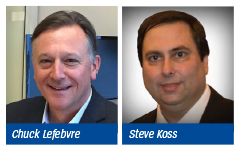|
||
 |
||
| A Quarterly Newsletter for Unisys ClearPath Forward Clients | August 2018 | ||
Success Through Succession Planning
By Chuck Lefebvre, Senior Director, ClearPath Forward Product Management, and Steve Koss, Distinguished Engineer and Global Team Lead, Product Services Solution Office, Unisys After decades of commercial availability – and just as many Workforce demographics are in the midst of a dramatic shift. And with turnover accelerating, many clients face a reality in which the people they’ve entrusted with knowledge of their ClearPath Forward environment may soon be departing the team. But in no way is this situation unique to our clients. It’s happening in many industries, and impacting a wide array of businesses, the world over. After working to get out ahead of this issue – and successfully implementing processes designed to quickly onboard new team members – what we’ve determined is that a formalized, proactive succession plan is critical to making sure you continue to get the most out of your environment, even as one generation of employees gives way to the next. In this context, a succession plan should achieve two main aims: Limit the impact these departures have on your operations, and make it easier to attract, hire, and onboard new team members. To support and facilitate these goals, we’ve outlined four key strategies you can utilize to simplify your succession planning, while making sure it accounts for your most critical business, IT, and staffing needs. Evolving the CoreWhen it comes to creating an environment that’s welcoming – and attractive – to new programmers, familiarity is everything. That’s why we’ve invested considerable time and effort around utilizing contemporary technologies and UIs wherever applicable within the ClearPath Forward environment. For instance, since Microsoft® Visual Studio® and the Eclipse IDE are both are mainstays in the curriculum at many universities, we’ve made these tools cornerstones of the environment’s development capabilities. Likewise, we’re working more point-and-click interfaces into the environment – and continue to update tools like the ClearPath Forward ePortal – so new team members can work in a manner that’s immediately intuitive. Emphasizing familiarity in this way essentially removes deep knowledge of the ClearPath Forward environment as a prerequisite to success. Instead, your new hires just need to focus on the goals they want to accomplish, and the tools that will help them get there. Handling it for YouYour business is your main focus – and rightly so. But for some, it can be challenging to find the time and resources to help the organization capitalize on the latest opportunities. With our help, you can stay focused on critical business strategies, not tactical IT matters. We can work with you to augment your staff, giving you access to a deep pool of proven ClearPath Forward experts you can turn to as needs dictate. Or, we can take it a step further and oversee parts or all of your ClearPath Forward environment, so you can focus more attention on advancing your business. As a result, you’ll be able to keep your environment in a state of continuous optimization, get more from Capturing Knowledge Before it’s GoneWhen a valued team member retires, the void they leave behind isn’t purely physical. They’ll also be taking considerable expertise with them. To mitigate any lasting effects of these departures, we’ll work with you to capture and automate specific processes and actions, so the newest additions to your team can easily carry forward the work of their predecessors. Application discovery – the process of extracting and documenting the knowledge of how your programs work – is equally as important. Because this critical knowledge usually resides in the heads of just a few key individuals, formally capturing and documenting it will help you further minimize knowledge gaps that could emerge during periods of turnover. Building Your ProficiencyWe learn best by doing. So the sooner you’re able to let your new hires get their hands on the systems they’ll be interacting with every day, the quicker they’ll become productive members of the team. With access to a blend of training courses – available onsite, online, and via self-study – you’ll help your staff come up to speed faster. And even though the environment is becoming more and more intuitive by Getting StartedWhile we’ve provided a fairly prescriptive outline for what it should include, your succession plan is sure to be as unique as your business. To help it reflect your specific needs, we recommend starting with a formal skills assessment. By understanding what you have today, what’s leaving, what you’ll be left with, and what you’ll need, the assessment will help you proactively manage these changes – and leave you better equipped to absorb their impact. Pair this with one of our Innovation Workshops, which help your organization identify key goals and any barriers standing in their way, and you’ll feel confident knowing your succession plan incorporates the proper strategic considerations. Ultimately, it’s about more than simply knowing what people to replace. It’s about building a lasting continuity of skills, knowledge, and expertise, so nothing stands between you and where the ClearPath Forward environment can take your business tomorrow. |
||
|
||
| Subscribe | Unisys.com | Comment | Newsletter Archive | ||
|
||




